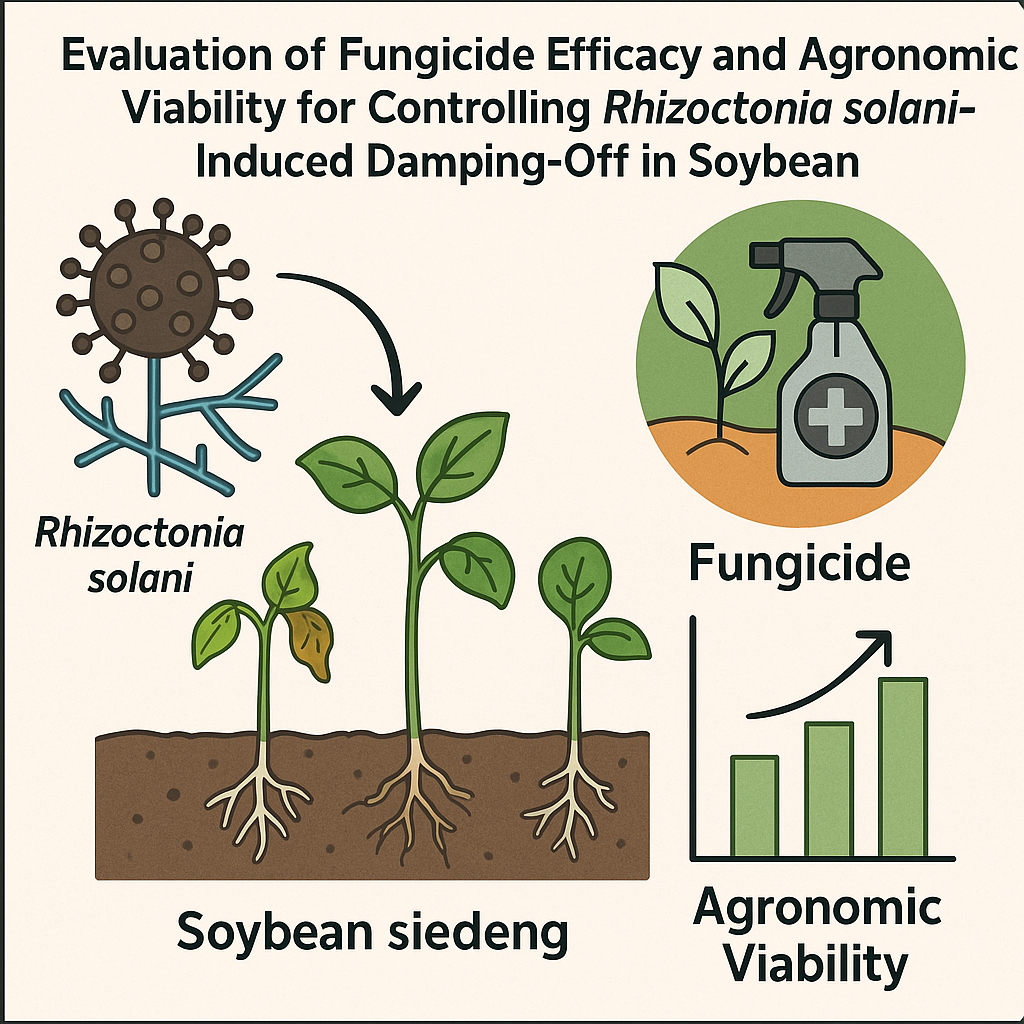Evaluation of fungicide efficacy and agronomic viability for controlling Rhizoctonia solani-induced damping-off in soybean
DOI:
https://doi.org/10.14295/bjs.v4i8.766Keywords:
soybean, fungicidal activity, Rhizoctonia, Thiabendazole, grain yieldAbstract
This study aimed to evaluate the agronomic efficacy of different fungicides applied via seed treatment for the control of Rhizoctonia solani AG-4 in soybean (Glycine max (L.) Merrill). The experiment was carried out in a greenhouse in Rio Verde, GO, Brazil, during the 2023/2024 growing season, using the Bônus 8579RSF IPRO cultivar previously inoculated with the pathogen. Nine treatments, including controls, were tested at the manufacturers' recommended doses. The evaluated parameters included emergence, vigor, shoot height, root length, pre- and post-emergence damping-off, disease index, and product efficacy. The experimental design was completely randomized with four replications. Results showed that the treatments Fludioxonil + Metalaxyl-M + Thiabendazole and Thiophanate-methyl + Fluazinam exhibited the highest control efficacy, reducing the disease index by 73.79% and 58.39%, respectively. It is concluded that seed treatment is an effective and viable strategy for the preventive management of Rhizoctonia solani during the initial development stages of soybean cultivation.
References
Akber, M. A., & Fang, X. (2024). Research progress on diseases caused by the soil-borne fungal pathogen Rhizoctonia solani in Alfalfa. Agronomy, 14(7), 1483. https://doi.org/10.3390/agronomy14071483 DOI: https://doi.org/10.3390/agronomy14071483
Babli, T., & Tiwari, A. (2022). Evaluation of fungicides against growth of Rhizoctonia solani under in vitro conditions. Biological Forum – An International Journal, 14(2), 56-62.
Bradley, C. A. (2008). Effect of fungicide seed treatments on stand establishment, seedling disease, and yield of soybean in North Dakota. Plant Disease, 92, 120-125. DOI: https://doi.org/10.1094/PDIS-92-1-0120
Canteri, M. G., Althaus, R. A., Virgens Filho, J. S., Giglioti, É. A., & Godoy, C. V. (2001). SASM-Agri: sistema para análise e separação de médias em experimentos agrícolas pelos métodos Scott-Knott, Tukey e Duncan. Revista Brasileira de Agrocomputação, 1(2), 18-24.
CONAB. (2025). Companhia Nacional de Abastecimento. Acompanhamento da safra brasileira: grãos – safra 2023/24. Brasília, DF: Conab, 2024. Disponível em: https://www.conab.gov.br. Acesso em: 10 jun. 2025.
EMBRAPA. (2025). Empresa Brasileira de Pesquisa Aagropecuária. Soja: principais doenças e seu manejo. Londrina: Embrapa Soja, 2023. Disponível em: https://www.embrapa.br/soja. Acesso em: 10 jun. 2025.
Goulart, A. C. P., & Fancelli, A. L. (2006). Efeito do tratamento de sementes de algodoeiro com fungicidas no controle do tombamento em relação à densidade de inóculo de Rhizoctonia solani. Summa Phytopathologica, 32(4), 360-366. DOI: https://doi.org/10.1590/S0100-54052006000400007
Goulart, A. C. P. (2022). Effectiveness of fungicide seed treatment in the control of soybean seedling damping-off caused by Rhizoctonia solani under greenhouse conditions. Summa Phytopathologica, 48(3), 121-125. DOI: https://doi.org/10.1590/0100-5405/266033
Guo, B., Sun, L., Ren, H., Sun, R., Wei, Z., Hong, H., Luan, X., Wang, J., Wang, X., Xu, D., Li, W., Guo, C., & Qiu, L-J. (2022). Soybean genetic resources contributing to sustainable protein production. Theoretical and Applied Genetics, 135, 4095-4121. https://doi.org/10.1007/s00122-022-04222-9 DOI: https://doi.org/10.1007/s00122-022-04222-9
Henning, A. A., França-Neto, J. B., & Zucchi, M. I. (2014). Tratamento de sementes de soja: fundamentos e tecnologias. Londrina: Embrapa Soja, 80 p.
Kurm, V. et al. (2023). Soil suppressiveness against Pythium ultimum and Rhizoctonia solani in long-term field trials. Microbial Ecology, 85, 1029-1042.
McKinney, H. H. (1923). A new system of grading plant diseases. Journal of Agricultural Research, 26(9), 195-218.
Mertz, L. M. (2019). Avaliação de fungicidas no tratamento de sementes para controle de Rhizoctonia solani em soja. Summa Phytopathologica, 45(3), 250-256.
Russ, T. et al. (2024). Aplicação de fungicidas na fase vegetativa da soja: principais doenças. Cerrado: Agricultural and Biological Research, 1(3), 22-34.
Singh, S. P., Gupta, R., Gaur, R., & Srivastava, A. K. (2016). Streptomyces spp. alleviate Rhizoctonia solani-mediated oxidative stress in Solanum lycopersicum. Annals of Applied Biology, 168(2), 232-242. https://doi.org/10.1111/aab.12259 DOI: https://doi.org/10.1111/aab.12259
Utiamada, C. M. (2024). Eficiência de fungicidas no controle de Rhizoctonia solani no tratamento de sementes de soja. Revista Ceres, 71(1), 87-95.
Zaaboul, F., Zhao, Q., Xu, Y-J., & Liu, Y-F. (2022). Soybean oil bodies: A review on composition, properties, food applications, and future research aspects. Food Hydrocolloids, 124(Part A), 107296. https://doi.org/10.1016/j.foodhyd.2021.107296 DOI: https://doi.org/10.1016/j.foodhyd.2021.107296

Downloads
Published
How to Cite
Issue
Section
License
Copyright (c) 2025 Bruno Pereira de Eça Vivas, Matheus Vinícius Abadia Ventura, Antonio Carlos Pereira de Menezes Filho

This work is licensed under a Creative Commons Attribution 4.0 International License.
Authors who publish with this journal agree to the following terms:
1) Authors retain copyright and grant the journal right of first publication with the work simultaneously licensed under a Creative Commons Attribution License that allows others to share the work with an acknowledgement of the work's authorship and initial publication in this journal.
2) Authors are able to enter into separate, additional contractual arrangements for the non-exclusive distribution of the journal's published version of the work (e.g., post it to an institutional repository or publish it in a book), with an acknowledgement of its initial publication in this journal.
3) Authors are permitted and encouraged to post their work online (e.g., in institutional repositories or on their website) prior to and during the submission process, as it can lead to productive exchanges, as well as earlier and greater citation of published work.



